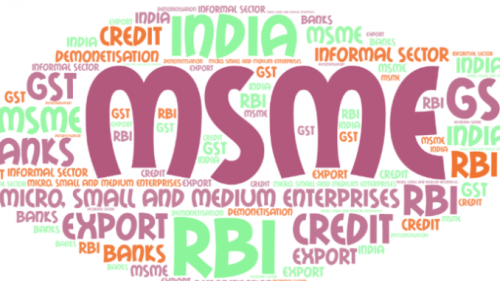
India is one of the fastest-growing economies in the world, aiming to hit the target of USD 5 trillion by 2024. Ever since the government announced its vision to achieve this target, economists and financial experts have been stressing the significance of strengthening the MSME sector. India’s vision of becoming a global economic power is undoubtedly possible only when the MSME sector can contribute further to the economy.
Besides contributing to economic growth, the MSME sector is considered as a catalyst for socio-economic transformation in India. It largely contributes to various national objectives like employment generation, poverty eradication, and resistance to rural-urban migration. To sum up, MSME plays a significant role in national development in multiple ways.
In this blog, let’s explore the Indian MSME sector in detail and its prospects in numbers.
Also Read: MSME Loans: The Optimum Choice For Small Industries
Defining MSME
Table of Contents
- 1 Defining MSME
- 2 The limits are:
- 2.0.1 Investment in micro industries should not exceed Rs 2,500,000
- 2.0.2 Investment in small industries is between Rs 2,500,000 and Rs 50,000,000
- 2.0.3 Investment in medium industries is between Rs 50,000,000 and Rs 100,000,000
- 2.0.4 Investment in micro industries should not exceed Rs 10,00,000
- 2.0.5 Investment in small industries is between Rs 10,00,000 and Rs 20,000,000
- 2.0.6 Investment in medium industries is between Rs 20,000,000 and Rs 50,000,000
- 3 MSME is defined and categorized as follows
- 3.0.1 A microenterprise is a unit that produces goods or renders services with annual turnover below INR 5 crores.
- 3.0.2 A small enterprise is a unit that produces goods or renders services with an annual turnover of more than INR 5 crores but does not exceed INR 75 crores.
- 3.0.3 A medium enterprise is a unit that produces goods or renders services with an annual turnover of more than INR 75 crores but does not exceed INR 250 crores.
- 4 MSME –The present scenario
- 5 As per the latest available official estimates:
- 6 Role of MSME in our economy
- 7 A solution to unemployment
- 8 A promising future!
- 9 In conclusion
Micro, Small and Medium Enterprise, fondly called as MSME, is majorly classified into two categories – manufacturing enterprise and services enterprise sector. The definition and classification of MSME are based on the Micro, Small and Medium Enterprises Development Act (MSMED) of 2006.
The definition of MSME in the manufacturing sector is based on capital investment in plant and machinery.
The limits are:
Investment in micro industries should not exceed Rs 2,500,000
Investment in small industries is between Rs 2,500,000 and Rs 50,000,000
Investment in medium industries is between Rs 50,000,000 and Rs 100,000,000
In services, the definition is based on the investment made on equipment, and the limits are as follows:
Investment in micro industries should not exceed Rs 10,00,000
Investment in small industries is between Rs 10,00,000 and Rs 20,000,000
Investment in medium industries is between Rs 20,000,000 and Rs 50,000,000
As per the amendment of 2018, MSME is defined and categorized in terms of business turnover.
MSME is defined and categorized as follows
A microenterprise is a unit that produces goods or renders services with annual turnover below INR 5 crores.
A small enterprise is a unit that produces goods or renders services with an annual turnover of more than INR 5 crores but does not exceed INR 75 crores.
A medium enterprise is a unit that produces goods or renders services with an annual turnover of more than INR 75 crores but does not exceed INR 250 crores.
Also Read: Best Government Business Loan Schemes For MSMEs In India
MSME –The present scenario
MSME sector has reported commendable growth since the last two decades. It is estimated that the number of MSMEs in India has increased by 207 percent between 2000-01 and 2009-10 with a CAGR of 21.52 percent.
With increasing recognition of its significance in the economy, the MSME sector is growing with leaps and bounds in the last few years. Government initiatives such as Make in India to boost manufacturing, PM Mudra Yojana for disbursements of small business loans, etc. have been mostly favorable for the MSME ecosystem.
As per the latest available official estimates:
Number of micro industries in India – 6.305 crores
Number of small scale industries in India – 3.3 lakhs
Number of medium scale industries in India – 5000
The sector manufactures more than 6000 types of products. It ranges from traditional coir goods to most modern electrical machinery. It includes commonly-used consumer goods to high-precision, sophisticated finished products.
Also Read: Business Loans For MSMEs — Overview, Features & Benefits, Eligibility, Interest Rates & More
Role of MSME in our economy
For any given country, the MSME sector is crucial in determining economic growth and stability. In the Indian context, MSME is considered as the backbone of the economy. It has constantly maintained a growth rate of over 10%. This sector contributes around 6.11% of the manufacturing GDP and 24.63% to the services sector GDP. In total, the MSME sector contributes nearly 30% to the GDP.
According to official data, the share of exports from the MSME sector stood at 48.01 percent in FY 2019, which is nearly half of the total exports. More than 95% of industrial units in the country are categorized under the MSME sector.
Also Read: Can Tech-Innovations Reshape MSME Lending In India?
A solution to unemployment
MSME is the second-largest employment-generator in the country after agriculture. The employment generating potential of the MSME sector has reported a CAGR of 11.74 percent in the last decade. MSME sector currently provides employment to 12.4 crore people in India. Moreover, it creates more than 13 lakh jobs every year.
One of the major objectives of Prime Minister Employment Generation Programme is to generate employment opportunities in the country through setting up of new self-employment ventures and microenterprises. If nurtured well, the MSME sector is capable of tackling the menace of unemployment in India. It promotes rural employment while restricting rural-urban migration. Out of the total MSMEs in India, around 59% are based in rural regions.
Off the record, it is estimated that when 2% of Indians start MSMEs and give employment to 25 people on an average, half of the Indian population will be employed.
Apply For MSME Loan
A promising future!
The future of the MSME sector looks bright with contributions from all its stakeholders and integration with global value chains. As pointed out by Nitin Gadkari, Union Minister for MSME, “The MSME sector contributes 29 percent to country’s GDP, and the government plans to take it to 50 percent in the next five years.” It is expected to create employment for around 15 crore people by 2024. India’s vision of becoming a USD 5 trillion economy is possible when the MSME sector contributes to 50% of GDP.
In conclusion
India’s MSME ecosystem is taking giant strides now, more than ever before, influenced by various factors like government policies, availability of small business loans, marketing assistance schemes, accelerators, and incubation facilities, general acceptance to entrepreneurship in the society, etc.
Are you planning to launch a business and in need of funding? Indifi is here to assist you! We provide customized loans without collateral for businesses. Apply for small business loans or MSME loan through our online lending platform. We ensure your quick assistance and hassle-free experience when you apply for small business loans!






